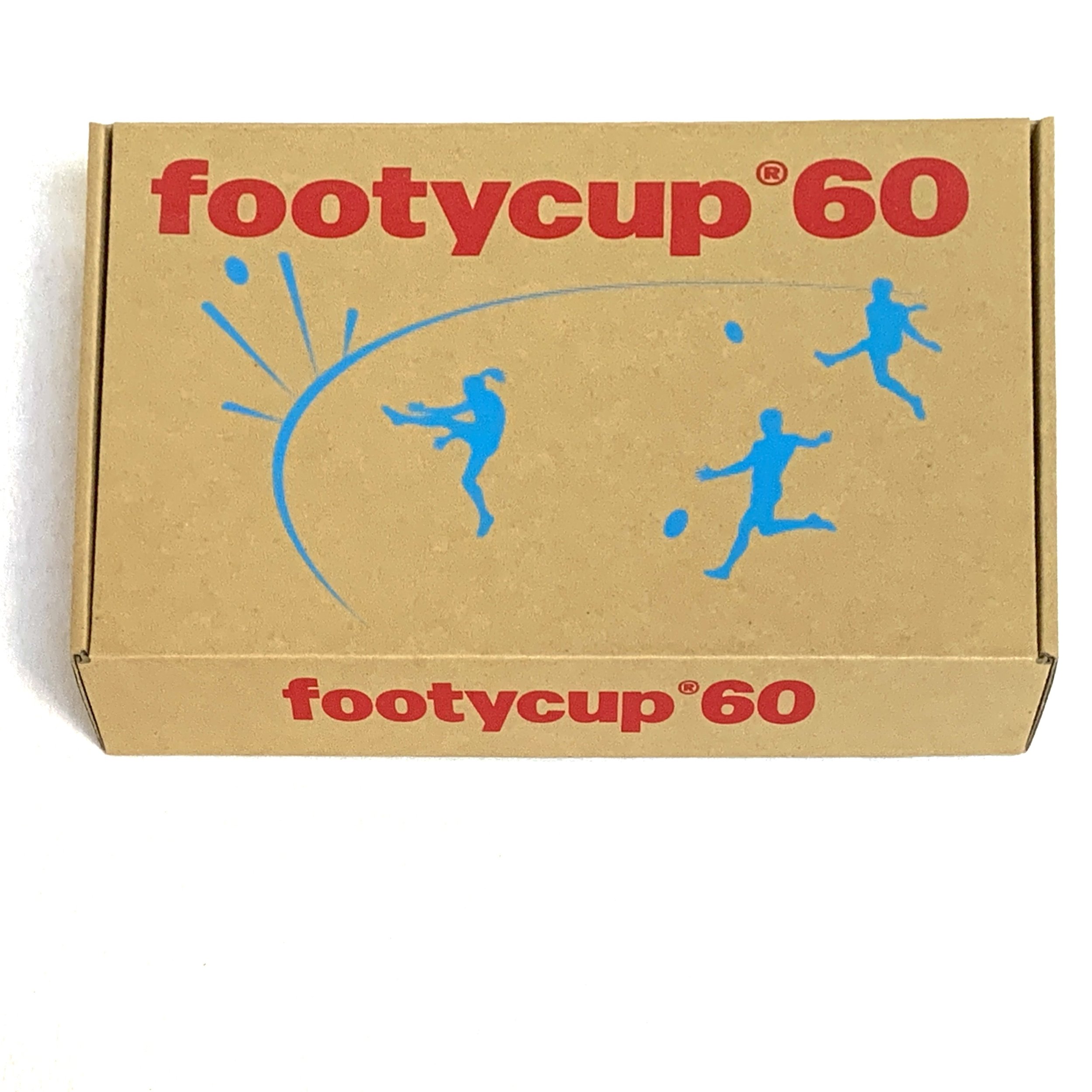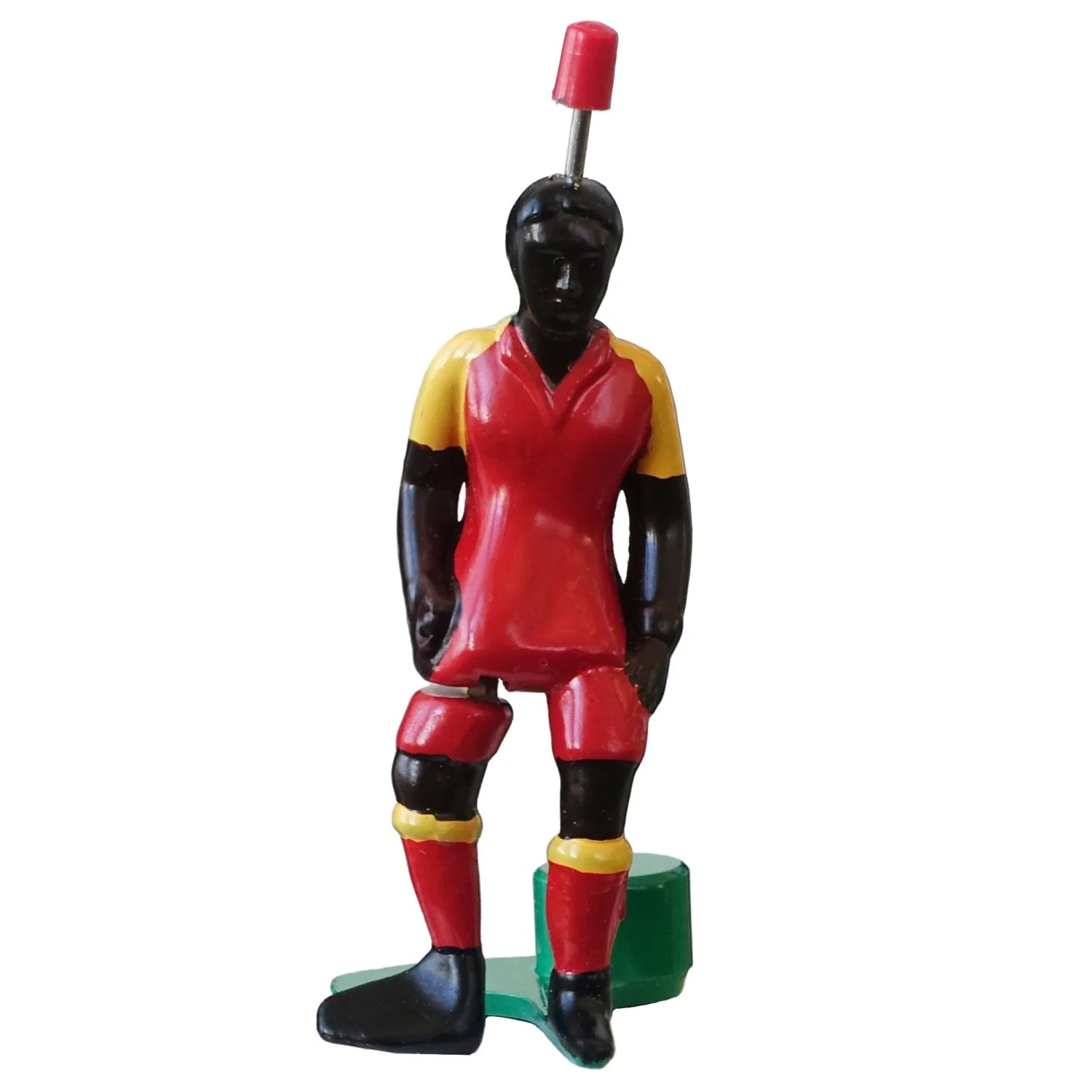FOOTYCUP AUSSIE RULES HISTORY
2001-2024
Growing up in Europe, loving playing the table soccer game TIPP-KICK as a child,
we wanted to buy it for our son.
Unfortunately it was not available in Australia so we started importing it in 2001, believing other people would enjoy it too.
In September 2001 we introduced Tipp-Kick to toy shops around Australia and in March 2003 at the Toy Fair in Melbourne.
After migrating to Australia in the 90’s, my Australian wife and I have been to some AFL games over the years, most notably a match at the MCG in 2000.
We were inspired to design and develop an Aussie Rules version of the very successful Tipp-Kick soccer game.
There was already a cricket, soccer and ice hockey board game available, but nothing for lovers of Australian Rules Football.
We began working on a footy version and by July 2001 the first FOOTYCUP set up was done and we went to a patent agent.
Over the years, in between running a business, building a house and raising a family, we modified the set up and try to keep it Australian made as much as possible.
The current version is now ready to launch and reflects our values of environmental sustainability and supporting other local businesses as much as possible.
We strive to keep the retail price down to sell directly online and by constantly trying to source best value material suppliers, so felt or timber might vary in size and colour which will not impact how to play this exciting game.
The TIPP-KICK of today is still the same game as it was in 1924, despite the arrival of computer and video games on the market.
We are optimistic that in the future, parents will still give their kids toys to touch and not just buttons.
100 YEARS OF TIPP-KICK 1924-2024
TIPP-KICK SOCCER HISTORY
TIPP-KICK is the worlds greatest table football (soccer) game.
In the old days the Americans made fun of the amazing success of things "Made in Germany", with rumours that VW Beetles were handmade by little dwarves in cages in the Black Forest.
In TIPP-KICK's case, this almost has some truth in it.
The Edwin Mieg OHG is a family business, which has produced little hand-painted play figures since 1924. The figures are virtually indestructible.
It is one of the few old games you can see in the Museum of German History in Bonn.
1920s TIPP-KICK advertisement
1920s TIPP-KICK delivery
1923-1925
TIPP-KICK is based on an idea of Carl Meyer, a cabinet maker who specialised in pharmacy furniture.
He invented the game at a time when football (soccer) itself was only beginning and was not yet a popular game.
He patented his invention in 1923.
The kickers were unique in their simplicity - just press a button on the head, and the metal rod transmits an impulse to make the leg flick forward to kick the ball.
In 1924, Edwin Mieg, a clock exporter from Schwenningen in the Black Forest, bought the patent.
The kickers were originally made of colourful printed tin, but this material was not tough enough to withstand the knocks involved in playing the game.
In spring 1925, at the famous annual Leipzig Expo, Mieg presented the new TIPP-KICK game, with kickers made from lead.
Each game included a rollable pitch with printed football (soccer) field markings, and a kicker and goalkeeper for both teams.
The pitch had a wooden stick at each end, into which the wire goals with flywire nets were hooked.
The goalkeeper was connected to a metal stick and he protected his goal made out of flywire. The goalkeeper was moved through a slot in the wooden stick.
In those days he saved a red and yellow painted ball made from pressed cork.
A sports shop in Chemnitz bought the first 144 games for 4.50 Goldmark each.
1923-1938 Kicker
1923-1952 Ball out of pressed cork
1923-1938 Goalkeeper with flywire net
1926-1938
At the first World Cup in Italy 1934, Germany's national team surprised everyone by taking third place.
That year TIPP-KICK become a popular present under German Christmas trees.
Between 1934 and 1938, TIPP-KICK became a top seller.
Soon after, Edwin Mieg installed a foundry in his own house and employed about ten people.
He also employed others who worked from their own homes.
1923-1938 TIPP-KICK box
1939-1952
Edwin Mieg died in 1949, aged 59 years.
His sons Peter and Hans-Joerg Mieg took over the company.
Before World War 2, Mieg's turnover from TIPP-KICK increased every year, but in the 1950s it went through a real boom.
The game pieces also changed again.
Before the 1950s, the ball got cut out of cork using special saws.
Since 1952 the 2-coloured and 12-sided TIPP-KICK BALL is made from plastic.
1952 Balls made from plastic
1953-1975
Since 1935, the goalkeeper had been made from zinc by the chill casting method.
Just in time for the World Cup in 1954, the new goalkeeper out of plastic got introduced. This one can dive left or right by pressing a button.
It is named Toni, after the German national goalkeeper Toni Turek.
Germany won their first World Cup in 1954 in Bern, Switzerland with 3:2 against Hungary.
Swept up by a wave of football fever, Germans bought 180,000 TIPP-KICK games that year.
In 1975 TIPP-KICK became more famous in France, and when football star Franz Beckenbauer moved from Bayern Munich to the United States, the Americans also became interested.
1954 Goalkeeper Toni
1960s TIPP-KICK delivery
1960s TIPP-KICK Peter Mieg
1976-1985
Meanwhile the TIPP-KICK kicker was still evolving.
He is now available with a choice of feet.
The STANDARD-KICKER has a normal round foot.
The TOP-KICKER has a flat foot, which is good for high shots and skilful chips.
These figures are now available in the colours of European Top Teams, and of course in all jerseys of the German Bundesliga.
The STAR-KICKER kicks with the inside foot and comes in colours of the national teams.
They have all become Collectables for TIPP-KICK enthusiasts.
In 1985, a new innovation was added to the goalkeeper.
The STAR-KEEPER enabling him to dive forwards towards the ball.
2011 STANDARD-KICKER WOMAN
TOP-KICKER
STAR-KICKER
1985 STAR-KEEPER
1986-1996
Since the death of Peter Mieg in 1991, the third generation of Miegs has taken over. Peter's son Mathias now runs the company together with Hans-Joerg and Jochen Mieg. 100,000 TIPP-KICK games are still sold every year.
The company currently employs 20 workers.
Every Tuesday, in a pre-fabricated building in the middle of a residential area, with a "clock-on" work timer out of the 1920s, a high pressure zinc casting machine spits out hundreds of kickers and legs.
Next to it, plastic goals and goalkeepers roll out of another machine.
The figures, already primed in skin colour, land on the tables of four dozen home-workers. They colour them in socks, shorts and jerseys, and paint hair, mouth and eyes on their heads.
1997 PRO KICKER
1997 PRO GOALKEEPER
1997-2000
The PRO-SET, as used in championships, has been available since 1997.
These figures are powder-coated blue with a spring steel mechanism and a stainless steel leg.
The PRO-KICKERS are produced by laser technology. They can kick an impressive variety of shots such as a steep chips, spins, curves, bounces and hard strikes with surprising precision.
The PRO-GOALKEEPER is connected with a steel rod to an aluminium block, without any buttons, as the championship players prefer it.
Since its beginnings, more than 6 million games of TIPP-KICK have been sold.
In Germany, Austria and Switzerland, nearly every child knows the game.
TIPP-KICK is much more than just a children's toy.
It holds a huge fascination for many adults, some of whom pursue that interest to Championship Competition level.
Those who share this passion for the game include famous German actors, TV announcers and rock singers .
The famous Hoeness brothers, Uli (Bayern Munich) and Dieter (VfB Stuttgart) have played TIPP-KICK since childhood.
Big companies use TIPP-KICK for promotion.
The zinc figures have even appeared on TV for famous TV series, advertisements and a preview for the Euro 2000 soccer tournament in Belgium and Holland.
Some TIPP-KICK games come with a surround which companies use for advertising.
Companies like SONY, PUMA, nutella, OPEL (German Holden), Hewlett Packard, AEG and TUC use TIPP-KICK fields, players and boxes with their logos as part of their advertising strategy.
TIPP-KICK CLUBS
In the 1930s and 1940s, many TIPP-KICK Clubs were founded.
The clubs named themselves after the top teams of the time, such as Schalke 04, Fortuna Dusseldorf, 1.FC Nuremberg and Dresdener SC.
In 1938, the TIPP-KICK Club TFG ’38 Hildesheim was founded. It is now the oldest club in existence and its members still compete in the German Championship.
From 1959 German Championships were held every 2 years, on specially produced tournament tables.
Since 1974, championships have been held every year.
More than 2000 adults from more than 200 clubs currently compete in 5 divisions for the German Championship title.
Meanwhile a youth league is well established.
In Austria and Switzerland many clubs compete for national titles.
These three countries also compete in international championships.
Regular tournaments are also held in other countries.
WORLD CUP FINAL 1954
WORLD CUP FINAL 1974
WORLD CUP FINAL 1990
WORLD CUP FINAL 2014



























